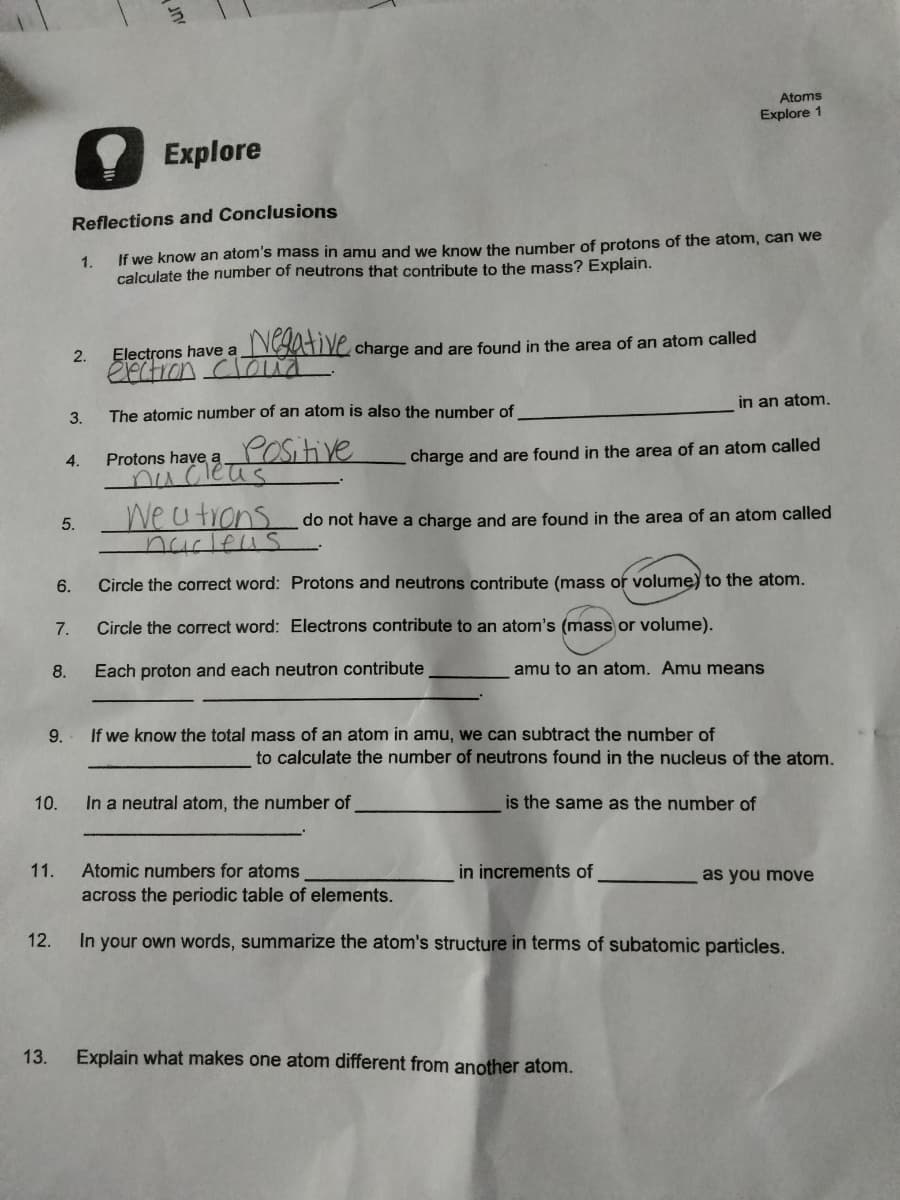3. 10. 1. 2. 8. Reflections and Conclusions If we know an atom's mass in amu and we know the number of protons of the atom, can we calculate the number of neutrons that contribute to the mass? Explain. 7. 6. 3. 4. 5. 1. 2. Negative charge and are found in the area of an atom called Jour Electrons have a electron The atomic number of an atom is also the number of Positive Protons have a nucleus 9. If we know the total mass of an atom in amu, we can subtract the number of charge and are found in the area of an atom called We utrons do not have a charge and are found in the area of an atom called nucleus Circle the correct word: Protons and neutrons contribute (mass of volume) to the atom. Circle the correct word: Electrons contribute to an atom's (mass or volume). Each proton and each neutron contribute amu to an atom. Amu means In a neutral atom, the number of in an atom. to calculate the number of neutrons found in the nucleus of the atom. is the same as the number of Atomic numbers for atoms across the periodic table of elements. In your own words, summarize the atom's structure in terms of subatomic particles. in increments of Explain what makes one atom different from another atom. as you move
3. 10. 1. 2. 8. Reflections and Conclusions If we know an atom's mass in amu and we know the number of protons of the atom, can we calculate the number of neutrons that contribute to the mass? Explain. 7. 6. 3. 4. 5. 1. 2. Negative charge and are found in the area of an atom called Jour Electrons have a electron The atomic number of an atom is also the number of Positive Protons have a nucleus 9. If we know the total mass of an atom in amu, we can subtract the number of charge and are found in the area of an atom called We utrons do not have a charge and are found in the area of an atom called nucleus Circle the correct word: Protons and neutrons contribute (mass of volume) to the atom. Circle the correct word: Electrons contribute to an atom's (mass or volume). Each proton and each neutron contribute amu to an atom. Amu means In a neutral atom, the number of in an atom. to calculate the number of neutrons found in the nucleus of the atom. is the same as the number of Atomic numbers for atoms across the periodic table of elements. In your own words, summarize the atom's structure in terms of subatomic particles. in increments of Explain what makes one atom different from another atom. as you move
Related questions
Question
100%

Transcribed Image Text:10.
12.
13.
8.
9.
11.
7.
4.
6.
2.
3.
5.
Reflections and Conclusions
1.
If we know an atom's mass in amu and we know the number of protons of the atom, can we
calculate the number of neutrons that contribute to the mass? Explain.
Explore
Negative charge and are found in the area of an atom called
Electrons have a
electron cloud
The atomic number of an atom is also the number of
Positive
Protons have a.
nucleus
charge and are found in the area of an atom called
We u trons do not have a charge and are found in the area of an atom called
nucleus
Circle the correct word:
Circle the correct word: Electrons contribute to an atom's (mass or volume).
Each proton and each neutron contribute
amu to an atom. Amu means
If we know the total mass of an atom in amu, we can subtract the number of
Atoms
Explore 1
Protons and neutrons contribute (mass or volume) to the atom.
In a neutral atom, the number of
in an atom.
to calculate the number of neutrons found in the nucleus of the atom.
is the same as the number of
in increments of
Explain what makes one atom different from another atom.
Atomic numbers for atoms
across the periodic table of elements.
In your own words, summarize the atom's structure in terms of subatomic particles.
as you move
Expert Solution
This question has been solved!
Explore an expertly crafted, step-by-step solution for a thorough understanding of key concepts.
Step by step
Solved in 2 steps with 2 images
